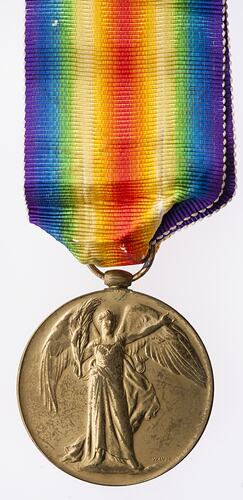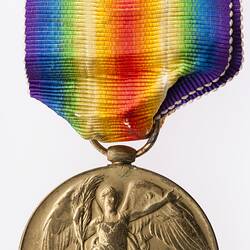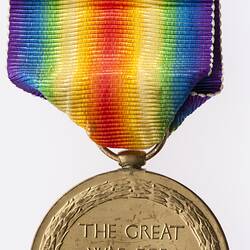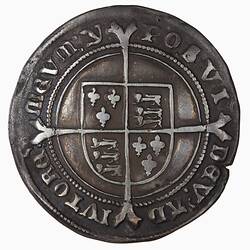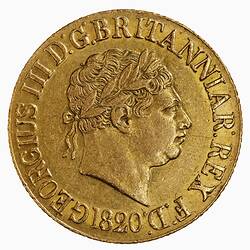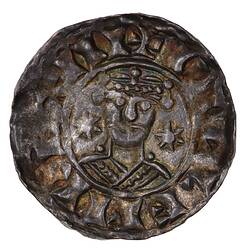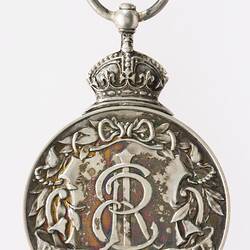Summary
Victory Medal 1914-1919 with ring mount and ribbon awarded to Pte. Albert Harrison Cox, service number 3279, 13th Battalion, A.I.F.
Private Cox was born in Maitland, NSW and was employed as a Grocer before joining on11 August 1915 in Sydney, aged 24 years 11 and months. He was wounded in action in France on 14 August 1916 by a gunshot wound to elbow so was sent to England. He returned to the front in France then suffered from trench feet in March 1917. He was hospitalised in England before rejoining the battalion. Private Cox returned to Australia on 13 April 1919.
The Victory Medal was authorised in 1919 and was awarded to army, navy and air force personnel who served in a theatre of war between midnight 4th-5th August 1914 and midnight 11th-12th November 1918. The Allies resolved that, if they wished to issue a Victory Medal, it would share a common feature of a depiction of Victory on the obverse and a ribbon of red, yellow, green, blue and violet merged into a rainbow pattern. This medal, that of Great Britain, was awarded to personnel from countries in the British Empire (some 5,725,000 were issued). The other Allied countries that issued Victory medals were: Belgium, Brazil, Cuba, Czechoslovakia, France, Greece, Italy, Japan, Portugal, Romania, Thailand, Union of South Africa and the United States of America.
Obverse Description
Figure of Victory facing three-quarters right with wings spread; in her right hand she holds a palm branch, her left hand is extended and open. The artist's initials, W.McM. (W. McMillan) are above the ground line on the right.
Reverse Description
The words, 'THE GREAT . WAR FOR . CIVILISATION 1914 - 1919' within a circular wreath of laurel.
Edge Description
Text; '3279 PTE. A.H. COX. 13 BN. A.I.F.'.
More Information
-
Collecting Areas
-
Date Issued
1919 AD
-
Issued By
-
Mint
-
Artist
-
Awarded To
Private Albert H. Cox, Australia, 1919
3279 Pte A.H. Cox, 13th Battalion, A.I.F. -
Inscriptions
Obverse; 'W.McM.' (W. McMillan - artist). Reverse; 'THE GREAT . WAR FOR . CIVILISATION 1914-1919'. Edge; '3279 PTE. A.H. COX. 13 BN. A.I.F.'.
-
Material
Bronze
-
Axis
12
-
Classification
-
Category
-
Discipline
-
Type of item
-
Overall Dimensions
50 mm (Height), 36 mm (Outside Diameter)
Height to top of ring.
-
Shape
Round with loop and ribbon
-
References
References: Http://www.naa.gov.au/The_Collection/Defence/Conflicts/ww1/ww1.html
[Book] Joslin, E C., et al. 1988. British Battles and Medals., 230 - 1 Pages
-
Keywords
